
Marine Corps F-35B landing on the USS Wasp
CAPITOL HILL: If the Commandant of the Marine Corps had one more dollar to spend — and he probably will with the recent budget deal — he’d use it to upgrade Navy ships’ electronics to take full advantage of the F-35 Joint Strike Fighter, he said this morning. The Marines’ new F-35Bs have the sensors to gather vast amounts of data and the computer smarts to “fuse” and make sense of it, experts tell us, but the Navy amphibious warships it will fly from lack the networks and computing to download and use all that intelligence.
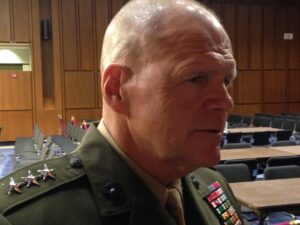
General Robert Neller
“Right now we’re not even close to having that discussion with some of our amphibs, particularly the big deck amphibs,” Neller said. (That’s the LHA and LHD classes, often referred to as mini aircraft carriers). “We’re putting a fifth gen airplane on that amphib and we’re running a less than fifth gen command and control suite. And so to me that would be the first thing.”
It’s worth noting that Gen. Robert Neller was speaking off the cuff after I asked him about his priorities at an event hosted by the Amphibious Warship Industrial Base Coalition. As it was, Neller thought aloud for a moment about various Marine Corps needs, from long-range firepower to more Navy attack submarines to clear the seas, before saying his top priority would be command, control, and networking upgrades to fully exploit the capabilities of the F-35. Nevertheless, this morning’s remarks give a pretty good preview of what the Marines will be telling Congress.
“We don’t have to have just… more ships, we’ve got to have more capable ships,” Neller said in his opening remarks. In particular, he went on, “the F-35 is a very capable airplane, but it’s got to be able to network. It will not realize its capability unless you can network that thing. You’ve got to exchange information not just between other airplanes, but (with) the ships that are in the fleet and….the force that’s going to go ashore.”
So, if you had that one more dollar, I asked Neller a few minutes later, what would you spend it on?
“That’s a tough question,” Neller replied. “Where’s the tradeoff, where’s the knee in the curve, between just more iron and better capability? I’d say the answer is in the middle. To buy a whole bunch of ships that don’t have survivability, that don’t have command and control, that don’t have air defense, that don’t have some form of surface-to-surface strike, is not going to solve the problem.”
Neller went on to reiterate his past statement that the Marines need the Navy to buy more attack submarines to clear the seas of enemy forces so the Corps can get ashore. But then he went back immediately to the electronics of command and control. While the hull, mechanical, and engineering systems of a ship can last for decades, when it comes to what “the command and control suite is going to be, you’ve got to build that thing with a little more open architecture” (i.e. be easier to upgrade), he said, “because if it takes five to seven years to build a ship. Who knows what the communications technology is going to be in five years?”
It’s from this remark that Neller went on to say matching 5th generation fighters with 5th generation command and control would be “the first thing” to get additional funding.
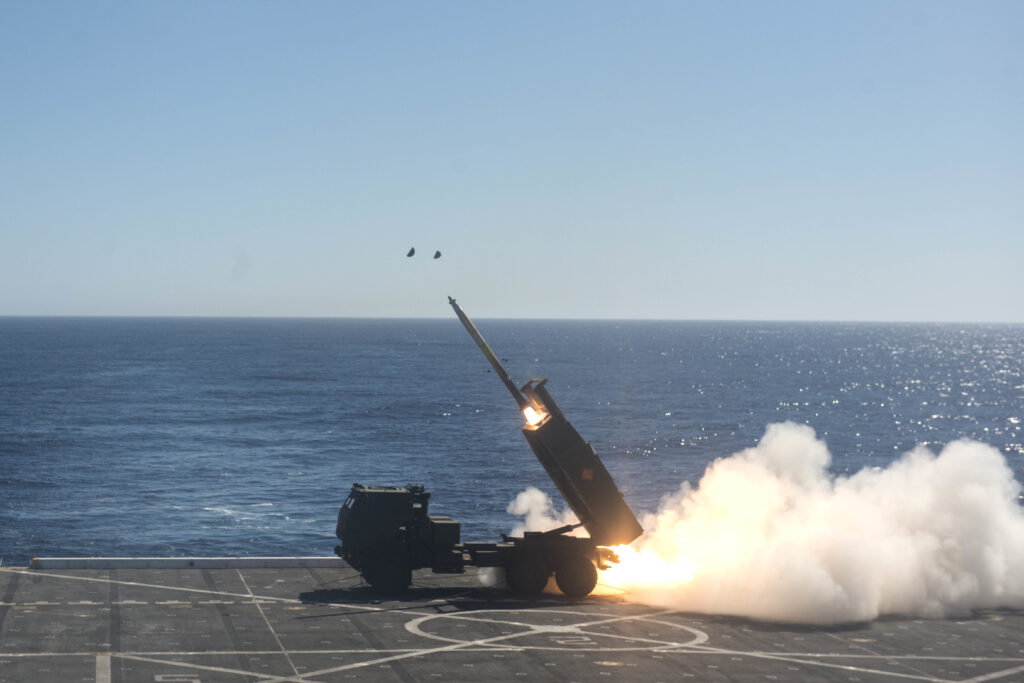
A Marine HIMARS missile launcher fires from the deck of the USS Anchorage during the Dawn Blitz 2017 exercises.
“A Fifth Generation Marine Corps”
“Fifth Generation” is an aerospace term referring to the latest US multi-role fighters, the F-22 and F-35, with their combination of stealth, advanced sensors, and sophisticated computing to “fuse” information from different sensors into a single coherent picture easily understood (in theory) by the pilot. At recent fora such as the Surface Navy Association, Neller has started talking in broad strokes about upgrading the rest of the force to match, what he’s been calling a “Fifth Generation Marine Corps.” His deputy commandant for combat developments, Lt. Gen. Robert Walsh, spoke at the AFCEA-USNI WEST conference in San Diego about 5th generation urban warfare and 5th gen armored reconnaissance vehicles that would bring F-35-like information gathering to the ground force. But this morning is the most specific I’ve heard a Marine Corps leader get about priorities.
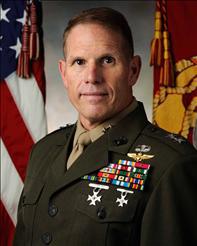
Lt. Gen. Robert Walsh
There’s a real need to upgrade both technology and the training of the humans who use it, independent experts told us. “The F-35 airframe is a large flying computer that is surrounded by an extensive sensor web,” said retired Navy captain Jerry Hendrix, now with the Center for a New American Security. “The spatial awareness that it provides its pilot is exceptional, and one of the concerns that I have raised in the past with senior leaders is whether young F-35 pilots are going to be experienced enough and wise enough to make full use of the information that is provided to them.”
It’s not just the pilots in the planes, Hendrix continued, it’s the officers on the ships. Different ships have more or less modern equipment depending on when they last got an upgrade, but “almost none of our ships are equipped communications-wise to make full use of all of the information an F-35 can send to them in real time,” he told me. “If one F-35 pilot, through his helmet, can get a 3-D understanding of the 360-degree bubble that is around him out for hundreds of miles, how do you convey several of those ‘bubbles’ back to the ship and the leadership embarked there simultaneously, especially if those F-35s are flying out different vectors and ranges from the ship?”
“The introduction of the F-35B to the fleet is a considerable upgrade; it cannot be seen as just an updated AV-8B,” agreed retired commander Bryan McGrath, now with the Hudson Institute. “The key to getting our money’s worth is ensuring that the sensor data that the F-35B generates gets off the plane and back to the shooters. It is important to recognize the huge philosophy shift that General Neller is giving a glimpse of. The F-35B, in addition to being a MEU asset, is a fleet asset, and the incredible information that it generates has to find its way to the fleet. ”
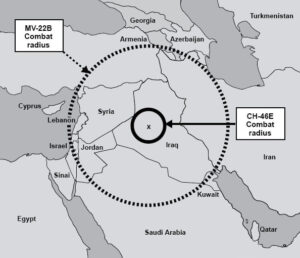 The problem even predates the F-35, said Robbin Laird, a well-connected consultant and Breaking Defense contributor. When the Marines replaced CH-46 helicopters that could fly at most 100 nautical miles from a ship with V-22 tiltrotors that could fly over 400, they outgrew the command and control capabilities of Marine Expeditionary Units and the Amphibious Ready Groups they sail on.
The problem even predates the F-35, said Robbin Laird, a well-connected consultant and Breaking Defense contributor. When the Marines replaced CH-46 helicopters that could fly at most 100 nautical miles from a ship with V-22 tiltrotors that could fly over 400, they outgrew the command and control capabilities of Marine Expeditionary Units and the Amphibious Ready Groups they sail on.
“It is not so much and F-35 issue as it is a fleet issue,” Laird said. “With the coming of the Osprey, the classic ARG-MEU which operated within a 200 square mile box was over time shifted to a distributed force operating over a much larger area and C2 issues emerged rapidly.” That issue of scale just becomes more pressing with each new system fielded: not just the F-35 itself but also the America-class big deck amphib, the CH-53K heavy lift helicopter, and the future MUX scout drone.
In budgets to date, “the Navy has prioritized the carriers and their needs over the amphibious fleet, but with the innovations in the amphibious fleet, attitudes are changing,” Laird said. “The Navy needs to adjust its C2 investments to the emergence of the new amphibious task force empowered by airpower transformation.”
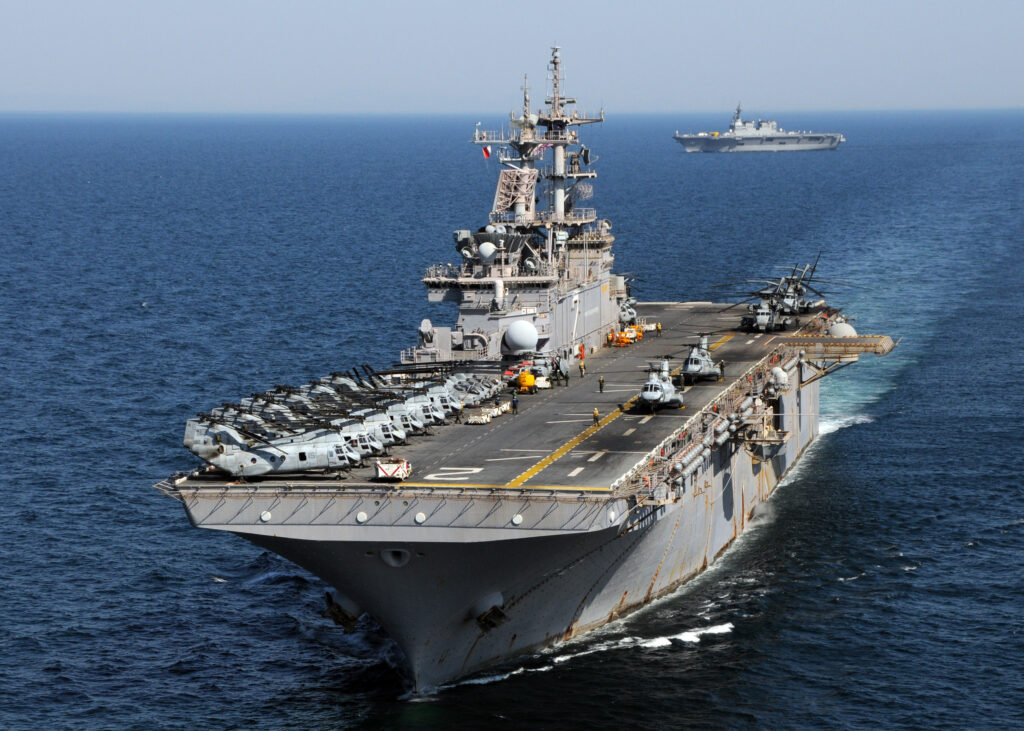
The ampihibous assault ship USS Essex (LHD-2)
Quality over Quantity
The Commandant’s call to upgrade the ships, not just build more, was just one reflection of his general emphasis on quality over quantity. “I would trade numbers of ships for capability if I had (to), if that was the trade,” Gen. Neller told the AWIBC gathering.
For example, one of the earlier speakers, Senate seapower subcommittee chairman Roger Wicker, had urged accelerating production of the big-deck America class. Wickers called for closing the currently planned gap of seven years between delivering the LHA-8 Bougainville, now ready to begin construction, and the as-yet unnamed LHD-9. Gen. Neller endorsed this idea with a marked note of caution:
“Moving some of the hull forms to the left would be good, but then again the Navy’s going to have to recruit, because you can’t just have the ships, you’ve got to have the sailors , you’ve got to have a crew,” he said. (The Navy’s currently about 7,000 sailors short).” I’ve got plenty of Marines to put on those ships.”
Now, Neller clearly wants more amphibious ships: The current total in service is 32, war plans require 38, and meeting all the theater combatant commanders’ demands would take “about 50,” he said But, equally clearly, he doesn’t want more at the expense of better. That extends beyond better electronics to integrate the F-35 and, just to name programs he mentioned this morning, includes
- long-range precision firepower to attack surface targets on land and sea from HIMARS and other launchers;
- more hovercraft and landing craft (“connectors”), including future robotic ones — “one day,” he said, “they’ll all be autonomous”;
- a new large MUX drone to scout ahead; and
- a fourth Puller-class multi-purpose Expeditionary Sea Base ship, formerly known as the Afloat Forward Staging Base.
- With the National Defense Strategy reorienting the armed forces from counterinsurgency to great power threats like Russia and China, Neller said, “we’re looking at all the things we’ve… not had to deal with for the past 17 years.. with the information and electronic warfare… air defense, things like that.”
But the F-35 is clearly at the top of the Commandant’s mind, and the pressure is mounting to get the fleet ready to make full use of it. “The F-35 is bouncing on the Essex right now,” Neller said. “We’re not waiting. This isn’t something that’s going to happen, it’s happening. 13th MEU is going out this fall with F-35.”
Taking aim: Army leaders ponder mix of precision munitions vs conventional
Three four-star US Army generals this week weighed in with their opinions about finding the right balance between conventional and high-tech munitions – but the answers aren’t easy.


























